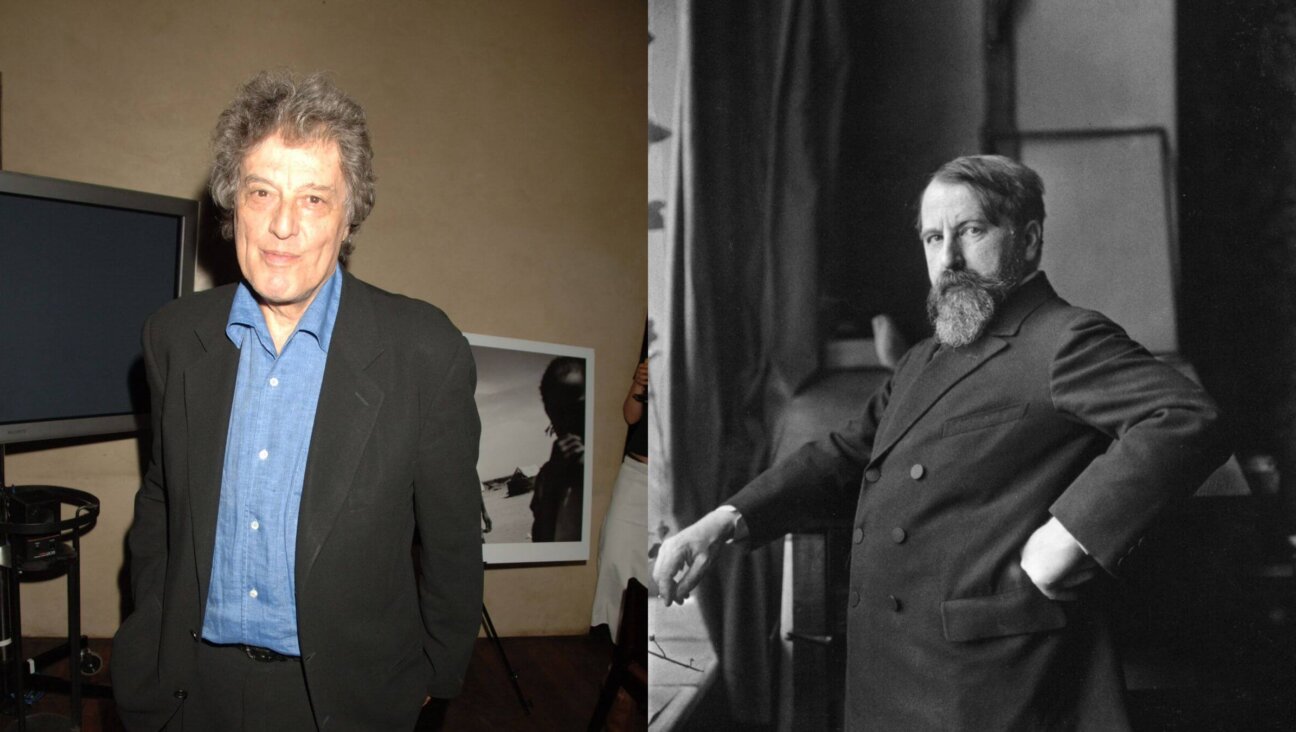How Hasidism Still Manages To Thrive

Hasidic rabbis, 2017 Image by Getty Images
Hasidism: A New History
By David Biale & 7 co-authors
Princeton UniversityPress, 896 pages, $45.00
In 1770, a young man of 18, later to be known as Solomon Maimon, traveled from Nesvizh in Lithuania to the court of Dov Ber, the foremost leader of the budding Hasidic movement, in the Polish town of Mezerich.
As Maimon would later describe, rumors had been spreading about this new movement, which sought to counter the “dryness” of traditional rabbinical studies and “the great burden of the ritual laws.” He’d heard that the group encouraged enjoyment of life’s pleasures. They were always cheerful. They sang, they danced, they drank and sometimes turned somersaults in the marketplace. Some said they even ran naked through the streets.
This he had to see for himself.
Maimon traveled for several weeks and arrived at the court of Dov Ber. After spending some time with the Hasidim and their master, he was puzzled and skeptical. One incident left him especially disturbed.
On an ordinary afternoon, a man came running to Dov Ber’s court to announce that his wife had given birth to a girl. The man’s friends offered him hearty mazel tovs. The maggid, hearing the ruckus, emerged from his study. “A girl?!” How could one express such joy over the birth of a female child? “He ought to be whipped.”
As Maimon told it, the poor fellow protested. He could not understand why he should be made to suffer for his wife having brought a girl into the world. But this was to no avail; he was seized, thrown down on the floor, and whipped unmercifully. All except the victim fell into a hilarious mood over the affair, after which the superior called them to prayer with the following words, “Now, brethren, serve the Lord with gladness!”
Maimon would later move to Berlin and become an associate of Moses Mendelsohn, a leading figure in the Haskalah movement, the Jewish Enlightenment. However, Maimon’s autobiography, believed to be the only extant eyewitness description of the maggid’s court, remains of particular interest for historians of Hasidism.
A few of those historians are the authors of the recent book “Hasidism,” a collaboration by David Biale, David Assaf, Samuel Heilman and several others. A mammoth work, “Hasidism” offers an unprecedented historical sweep of the eponymous movement, probing not only its rise and spread, but also its ethos, principles, practices and institutions, and it helps demonstrates just how complex, fluid and imaginative this movement has been. It also chronicles how an obscure 18th-century shamanistic, kabbalist rabbi, Israel Ba’al Shem Tov — known to scholars as the “Besht” — inspired a social movement that became one of the dominant religious forces among Eastern European Jews and spawned dozens of streams and sects all with very different orientations.
It was the maggid Dov Ber, however, rather than the Besht, who turned a mere circle of mystics and hangers-on into a genuine movement. After the Besht died in 1760, Dov Ber established his court in Mezerich and began to deploy emissaries across what was then the Polish-Lithuanian Commonwealth. The masses were quickly taken with Hasidism’s populist message and the personal charisma of Dov Ber and his disciples.
Solomon Maimon, however, was unimpressed. His own visit to Dov Ber left him disdainful of this new sect, sensing something dark and unsettling about it. As “Hasidism” notes, Maimon quickly determined that the Besht was “a quack and a charlatan,” who traded in “cabalistic hocus-pocus,” and Dov Ber “a fraud… his practices as a tzaddik a mere pack of tricks.”
This is more than just harsh judgment; it’s a reflection of deep contempt. We have no way of knowing whether the incident Maimon describes actually took place — its bizarreness certainly strains credulity. What we can be certain of, though, is that Maimon tells it because it’s effective as caricature. His contempt for Hasidim is explicit, which he makes clear in preceding and subsequent passages.
Maimon was not alone in his scorn. His account may be rare for its eyewitness quality, but Hasidism had already gained an unflattering reputation among modernizing Jews before the end of the 18th century. In 1791, Menachem Mendel Lefin, a member of the Berlin Haskalah who originally came from Podolia (which he later returned to), referred to this new sect as embracing “devout ignorance.”
Around the same period, Jacques Calmanson, a figure in the early Eastern European Haskalah, wrote that Hasidim was a sect that “rejects knowledge and makes a virtue out of ignorance.” They respect no knowledge other than Kabbalah, which, he said, their leaders are in fact ignorant of, pretending only to be mystics in order to exploit their followers for material gain. Ozjasz Ludwik Lubliner describes Hasidim as “Jewish Jesuits” for their fanaticism, calling them “enemies of the light, [who] carefully nurture the old prejudices and superstitions.”
While “Hasidism” advises us not to “exaggerate the significance” of these critiques, as its authors generally had little firsthand knowledge of Hasidim, it’s still striking how early these perceptions were formed — and how familiar they sound. One could easily hear them applied to Hasidim of today.
The sketches of Hasidim that Maimon and his Enlightenment colleagues drew — “cabalistic hocus-pokus,” “enemies of the light” making “virtue out of ignorance” — are undoubtedly simplistic and clearly lack appreciation for the movement’s populist appeal. This does not mean they are incorrect, but they’re certainly incomplete. Like the anti-Hasidic polemics of the centuries to follow, this was criticism of Hasidic life applied only to one dimension: its backwardness.
And yet, there’s no doubt that not only has Hasidism been able to attract thousands, but it’s also had remarkable staying power. The mystery is why Hasidism’s essence remains so elusive, incoherent and often contradictory, and so we are left to wonder where exactly its attraction lies. An even greater mystery is why most attempts to coherently define the movement are almost always contradicted by Hasidic life in practice.
In dictionaries and encyclopedias, Hasidism gets the boilerplate treatment: “A mystical movement stressing joy and ecstasy in religious practice.” A more thoughtful contributor might say something about the tzaddik — conduit between his followers and the heavens — or the institution of the rebbe’s court or the communal gatherings in song and dance and the powerful solidarity among group members.
I grew up as a Hasidic boy in Brooklyn, and I would not have recognized any of these descriptions in the life we lived. Rather, a quote I would hear often, attributed to the 18th-century Hasidic master Menachem Mendel of Rimanov, was more like it:
“Every button [fastened] left upon right, brings upon it thousands of klippot,” Menachem Mendel said.
Klippot, in kabbalistic literature, are demonic forces that are the source of human evil.
Shirt buttons might be an odd place for demonic forces to reside, but Jewish tradition favors the right over the left in all things — wash your right hand first, put your right sock on first, clip the fingernails on your right hand first and so forth — and so, too, button your shirts right side over left. Otherwise, you get the klippot.
Shirt buttons were of special concern to Menachem Mendel. In his day, the clothiers of the world — a nefarious cabal, for sure — began to manufacture men’s shirts and coats with their left sides fastened over their right. Menachem Mendel would not countenance such deviation from tradition, and therefore warned with the following admonition: Do not be tempted by the Gentile fashions! Coats and shirts shall always be buttoned right side over left!
In my community, this was Hasidism: rejection of modernity, separation from the outside world, uncompromising fealty to religious law and tradition and insistence on distinct cultural markers in such matters as language and dress. If I’d been asked, I would have said Hasidism was rigid and oppressive. Hasidism made life hard. Maybe God wanted this — I wasn’t in a position to know. But joyful it wasn’t.
This conjures a puzzle: How did a movement known at its inception as innovative and daring — joy and ecstasy! — come to represent the rigid legalism it was once thought to counter? How did Hasidism morph into the most reactionary, arch-conservative faction within all of Judaism today?
“Hasidism” goes a long way in answering these questions by charting the contours of the movement’s spread, along with its shape-shifting doctrines and principles. “Hasidism” also achieves a historical record setting of note, dismantling one of the major fallacies about the movement: the notion that it suffered a sharp decline in the 19th century, losing much of its vigor and vitality, to say nothing of its creative and innovative religious thinking.
This question matters significantly. A decline and a reorientation can have similar outward appearances, and sometimes, as the process unfolds, it isn’t clear which it is. Certainly, as the Hasidic movement entered 19th-century maturity, something shifted. What was to many a shift toward atrophy, however, was in reality a consolidation of the movement as social order equal to its function of religious revival. It is precisely in that maturity — its so-called “decline” — that the movement demonstrated both its versatility and the source of its unusual resilience.
Among those who perpetuated the notion of Hasidism’s decline were some of the early scholars of the movement, including the historian Simon Dubnow and the religious philosophers Martin Buber and Abraham Joshua Heschel.
“When modern writers rediscovered Hasidism in the first part of the 20th century,” the authors of “Hasidism” note, “they were quite naturally drawn to what they thought was innovative, even revolutionary in Hasidic thought.”
These non-Hasidic writers admired what they saw as Hasidism’s core ideals, except that they picked and chose that which stirred the modern mind and ignored what they saw as backward and fanatical as well as — more importantly — the movement’s inherent conservatism despite its doctrinal innovations.
Of course, then they saw a decline. The past can be idealized in a way that the present cannot. Dubnow, for instance, in his influential “Toldot Ha-hasidut” (“The History of Hasidism”), published in Hebrew in 1931, ended his history in 1815, the year the Seer of Lublin died and by which time Dov Ber’s disciples had all passed from the scene. At that point, according to Dubnow, the movement degenerated into an obsession with battling the Haskalah, “perverted by tzaddikism” and showing none of its earlier creativity in religious thought.
It wasn’t just non-Hasidim, though, who saw a decline; even the Hasidim themselves did.
In a letter written in 1910, Yitzhak Nahum Twersky, scion of the Chernobyl and Skver dynasties and later son-in-law to Yissachar Dov of Belz, lamented that after the deaths of the earlier tzaddikim, “the light of Hasidism has dimmed and its glory has gone into exile, and it has atrophied, continually declining, continually diminishing from day to day, until it is now a debased coin, a name entirely devoid of content.”
While Twersky was something of an anomaly (his words were written in a heartbreaking missive about the airlessness he personally felt within Hasidic life), other Hasidim of note held similar views.
Kalonymus Kalman Shapiro of Piasetshna, the legendary rebbe of the Warsaw Ghetto who refused to escape without his followers and was murdered by the Nazis in Treblinka in 1943, was himself one of the most creative Hasidic minds of the 20th century. According to “Hasidism,” however, Shapiro “agreed with many of the critiques of Hasidism as a movement that lost its original spirit and animating mysticism, becoming instead a rigid social framework devoid of any vitality.”
Hillel Zeitlin, a Polish Jewish intellectual who was raised within Chabad Hasidism, then left it, then returned to Hasidism later in life, wrote: “Hasidism in our time lacks the strength, energy and vitality…. of the Ba’al Shem Tov.” The Hasidim of his day, Zeitlin wrote, “chase after wealth and honor no less than [non-Hasidim]…. Dynasties quarrel with dynasties, raising an interminable ruckus…. They indulge in needless fanaticism while ignoring the pure love and fear of God.”
Most telling of all, perhaps, is the declaration by no less a figure than the old rebbe of Satmar, Joel Teitelbaum, the leader of what was to become the largest Hasidic sect in North America: “The teachings of the Ba’al Shem Tov have been forgotten.”
What both modern scholars and the Hasidim themselves appear to have forgotten were those earlier critiques of the movement, which denounced its leaders for their avarice and duplicity and its masses for their ignorance with no less zeal than later critics.
What’s more, “Hasidism” argues convincingly that what had been called a decline was in fact no such thing. “Between 1815 and World War I, Hasidism enjoyed a golden age. It was in this that the small elitist and mystical circles of the eighteenth-century coalesced into a genuine mass movement.”
What many saw as the movement’s weakness — the lack of well-articulated principles — was in fact its strength. This was a social movement that “was never monolithic in its ethos,” and it is precisely this quality that would come to define it. “The very lack of a rigid ideology allowed for a great variety in the forms of leadership, governing ethos, and types of practice.”
Nor was religious innovation over; in fact, the 19th and 20th centuries saw a plethora of new schools of thought. The schools of Peschischa and Kotzk in many ways overturned Hasidic orthodoxies by embracing an elitist ethos that appeared to contradict Hasidic populism. It was also out of Kotzk that came the remarkable school of Izhbitz — a subject popular today even among non-Hasidim — which advanced an antinomianist strain within a broader Hasidic framework.
It was also in the 19th century that the regal courts of Ruzhin were established, which might have seemed to outsiders as a turn to decrepitude, but which to the Hasidic masses offered an implied theory of the tzaddik as king. The trappings of wealth and comfort were symbolic and necessary; the institution demanded it, not the individual as figurehead.
Perhaps the most important 19th-century Hasidic innovation arose from the Habsburg Empire across the border from Tzarist Russia and Congress Poland, among them the Galician schools of Dinov and Belz and the Hungarian courts of Sighet and Munkatch. This was the fusion of Hasidic thought with the ultra-conservatism of the Hatam Sofer, whose rallying cry, perhaps ironically, was, “All innovation is forbidden by the Torah.”
Which brings us back to shirt buttons. Not all groups were concerned with such things, but all were concerned with issues of similar purpose: forms of practice, rituals, insisting on doing rather than theorizing and explaining. Rules and practices, Hasidim learned early on, give physical expression to principles and ideas. The latter might shape-shift and morph over time, but the practices will contain their essence. If Hasidism lacked a clearly articulated philosophy, its rituals and institutions were all the more important, as they became the primary vehicles for carrying an unarticulated ethos forward.
Strongest among those institutions was the rebbe’s court, which would become the defining characteristic of Hasidic life in the century after its first cohorts of leaders passed.
As “Hasidism” notes: “Whether in Ukraine, the Duchy of Lithuania, Galicia, or Central Poland, by the beginning of the nineteenth century one central characteristic was shared in common: the structure of the court with a tzaddik at its center surrounded by his Hasidim.” The institution of the court gained such powerful traction that it came to personify the Hasidic social model universally.
It is therefore not surprising that rituals and institutions form the core of Hasidic life even today. Customs and practices that developed organically over time gained weight as traditions on which the movement’s edifice depended. These were forms that held within them inchoate and sometimes even contradictory principles, but these containers of physical practice made theory matter less.
In this respect, “Hasidism” shows both what gave the movement its strength in its early years and its remarkable resilience even through the abysmal first half of the 20st century — through revolutions, pogroms, two world wars, the Bolshevik takeover of the very region within which the movement arose, an extermination attempt in which Hasidim lost disproportionate numbers and mass displacement from Eastern Europe to North America and Israel, all in less than a four-decade period. The courts then rose again out of the ashes and rebuilt stronger than ever.
The 20th-century Hasidic courts might appear spiritually meager, conflict-ridden, concerned mostly with amassing wealth and political influence, but “Hasidism” argues that the movement’s demise, so often predicted, is still nowhere on the horizon. While it might be challenging to find a clear ideological line between Hasidic and non-Hasidic ultra-Orthodoxy, that’s arguably due in significant measure to the non-Hasidic world’s adoption of the Hasidic ethos in many respects, including treating their leaders, or gedoilim, with the reverence accorded to Hasidic rebbes, and adopting Hasidic modes of song and dance as an expression of religious fervor.
Today, in North America alone, estimates show Hasidim will number nearly half a million by 2020, with comparable numbers in Israel, plus small but significant presences in such major European cities as London and Antwerp. Although technology has threatened its insularity, Hasidism has faced numerous challenges in its past, ultimately rising to greater strengths as the masses were galvanized against its threats. There’s reason to believe the pattern will continue.
Through its penetrating exploration of Hasidism’s past, “Hasidism” offers a lucid glimpse into its likely future: an enigmatic force of psychosocial impact that will remain strong as long as it fulfils its function: a cherished culture and a way of life that offers meaning and answers and makes order out of the chaos of life. That, perhaps more than anything, is what most of us seek. Those who are lucky enough to find it, won’t part with it quickly.
Shulem Deen is the author of the memoir “All Who Go Do Not Return.”















